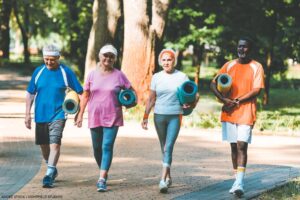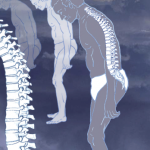‘Physical therapy is a mainstay of managing rheumatic diseases, but what’s the evidence, how do we monitor, and what types of therapy should we advocate?’ asks Physician Editor Bharat Kumar, MD, MME, FACP, FAAAAI, RhMSUS. ‘Here, we provide some practical recommendations for the everyday rheumatologist.’
Physical activity, including occupational and recreational activities, is one of the cornerstones of nonpharmacological therapy in patients with axial spondyloarthritis (axSpA). Engaging in regular physical activity offers a wide range of benefits with positive impacts on individuals, promoting not only physical health, but also mental and emotional well-being.
Defined as “any bodily movement produced by skeletal muscles that results in energy expenditure,” physical activity encompassing all forms of movement, whether planned or spontaneous.1 Exercise is considered a specific type of physical activity, a planned, structured and repetitive bodily movement done to improve or maintain one or more components of physical fitness.1
The Effects in axSpA
In patients with axSpA, physical activity, including exercise, has positive effects on several disease outcomes independent from pharmacological therapy, such as disease activity, physical function and general health.2,3 A study by Coulter et al. found th at physical activity can improve physical function, exercise capacity and spinal mobility in patients with axSpA.4 Conversely, inactivity was found to be associated with lower quality of life.4
at physical activity can improve physical function, exercise capacity and spinal mobility in patients with axSpA.4 Conversely, inactivity was found to be associated with lower quality of life.4
Pécourneau et al. found that exercise programs can improve disease activity and physical function in patients with axSpA.5
A systematic review by O’Dwyer et al. found that exercise interventions in patients with axSpA can improve physical function, disease activity, chest expansion, pain, stiffness, spinal mobility and cardiorespiratory function.6
In a study by Liang et al., the authors found that home-based exercise interventions can improve physical function, disease activity, depression and pain scores in patients with axSpA.7 However, a recent review also underscores the paradoxical effects of physical exercise in patients with axSpA, finding that excessive or inappropriate physical activity can lead to increased inflammation, pain and potential damage.8
Considering the overall evidence points to a more favorable outcome than harm, it is important to achieve a balance and tailor the exercise plan to each patient’s specific needs and limitations.
Exercise Recommendations
For adults with chronic rheumatic conditions, including axSpA, recommendations include performing 150–300 minutes of moderate intensity exercise or 75–150 minutes of vigorous intensity aerobic exercise each week, or an equivalent of combined aerobic exercise.9,10 Additionally, muscle strengthening activities of moderate or high intensity involving all major muscle groups on two or more days a week is recommended.9
Despite clear evidence supporting the benefits of exercise, approximately 25% of patients still engage in exercise less than once a week, even though they acknowledge the numerous potential benefits.11,12
For many individuals, including those for whom affordability and psychosocial factors are a barrier, making exercise accessible is crucial. Additionally, enhancing exercise habits among patients with axSpA can be attained by ensuring the intervention incorporates behavior change guidance.13 Promoting group exercise participation can also serve as a motivational factor.13
How to Monitor Physical Activity
To optimize health behavior changes related to exercise, it is helpful to accurately monitor physical activity in patients with axSpA in both clinical research and clinical practice settings. The general gold standard for measuring total energy expenditure is the doubly labeled water method. However, this is expensive, time-consuming and has a high subject burden. Therefore, it’s not feasible in daily clinical practice.
Physical activity monitoring apps, which are easily accessible, and accelerometers can be used as alternatives. A notable drawback of these instruments is the insufficient specification of the type of physical activity, making it difficult to identify potential areas for improvement, including activities promoting muscle strength.
Self-report questionnaires are low in cost, have a low patient burden and are also easily applicable in clinical practice. Importantly, information about the specific type of activity can be included. Available self-report questionnaires are the modified Short Questionnaire to Assess Health-enhancing physical Activity (mSQUASH) and the International Physical Activity Questionnaire (IPAQ).14,15
Among patients with axSpA, the mSQUASH tool showed better correlation with the accelerometer, was more sensitive to change and showed fewer missing values than IPAQ. Patients preferred the mSQUASH due to its fewer questions and clearer layout.16 Despite limitations, such as subjectivity and recall bias, the mSQUASH’s focus on physical activity in an average week reduces variation and improves reliability.
However, both mSQUASH and IPAQ tend to overestimate activity intensity, likely due to socially desirable responses.14 Overall, the mSQUASH is a valuable tool for standardizing daily physical activity assessment, aiding in patient self-management and personalized exercise planning.
The Role of Physical Therapy
In addition to physical activity, physical therapy is a cornerstone of non-pharmacological therapy for this population. The 2019 ACR/Spondyloarthritis Research and Treatment Network (SPARTAN)/Spondylitis Association of America (SAA) guidelines strongly recommend physical therapy for active and stable axSpA.17
Physical therapy for patients with axSpA may include therapeutic modalities (i.e., heat, ultrasound) and manual therapy (i.e., massage), but such passive interventions usually serve as adjunctive treatment to provide short-term symptom relief.
The mainstay of physical therapy treatment is active intervention, such as prescription of, and instruction in, therapeutic exercise that is tailored to each patient’s specific needs.18,19 Further, evidence has demonstrated that supervised physical therapy care has greater efficacy than home-based physical therapy, and that long-term, personalized and supervised exercise is more beneficial than usual care for patients with severe functional limitations due to axSpA, showing the value of one-to-one patient instruction on how to correctly perform exercise programs and support in behavior changes to optimize adherence over the long term.3,18,20
Conclusion
Guiding physical activity is a very important aspect in the management of axSpA because of its proven effects on general health, as well as specific disease-related outcomes. The management of axSpA demands more than pharmacological therapy and calls for an all-encompassing strategy that considers the physical and psychosocial aspects related to the disease. We propose that a holistic management approach is more likely to lead to better outcomes and a more empowered journey toward health and well-being for patients with axSpA.
 Yvonne M. van der Kraan, BSc, is an MD/PhD student at the department of rheumatology and clinical immunology at the University Medical Center Groningen, the Netherlands, and did an Assessment of SpondyloArthritis research fellowship on the translation and cross-cultural adaptation of the mSQUASH at the University of California, San Francisco. Her PhD focuses on chronic pain in patients with axial spondyloarthritis beyond inflammation.
Yvonne M. van der Kraan, BSc, is an MD/PhD student at the department of rheumatology and clinical immunology at the University Medical Center Groningen, the Netherlands, and did an Assessment of SpondyloArthritis research fellowship on the translation and cross-cultural adaptation of the mSQUASH at the University of California, San Francisco. Her PhD focuses on chronic pain in patients with axial spondyloarthritis beyond inflammation.
 Andrew Lui, PT, DPT, is a clinical professor in the department of physical therapy and rehabilitation science at the University of California, San Francisco. He is vice chair of faculty development and faculty affairs in this department and cares for patients with rheumatic and neurologic diagnoses.
Andrew Lui, PT, DPT, is a clinical professor in the department of physical therapy and rehabilitation science at the University of California, San Francisco. He is vice chair of faculty development and faculty affairs in this department and cares for patients with rheumatic and neurologic diagnoses.
 Anneke Spoorenberg, MD, is an associate professor and a rheumatologist in the department of rheumatology and clinical immunology at the University Medical Center Groningen, with a focus on spondyloarthropathy.
Anneke Spoorenberg, MD, is an associate professor and a rheumatologist in the department of rheumatology and clinical immunology at the University Medical Center Groningen, with a focus on spondyloarthropathy.
 Suzanne Arends, PhD, is an assistant professor and clinical epidemiologist in the department of rheumatology and clinical immunology at the University Medical Center Groningen. Her interest is in clinical/translational research on disease activity, outcome, and effect of treatment in rheumatic diseases. She is the principal investigator of the international mSQUASH project.
Suzanne Arends, PhD, is an assistant professor and clinical epidemiologist in the department of rheumatology and clinical immunology at the University Medical Center Groningen. Her interest is in clinical/translational research on disease activity, outcome, and effect of treatment in rheumatic diseases. She is the principal investigator of the international mSQUASH project.
 Lianne S. Gensler, MD, is a professor of medicine, director of the Ankylosing Spondylitis Clinic, and director of the Rheumatology Fellowship Program at the University of California, San Francisco.
Lianne S. Gensler, MD, is a professor of medicine, director of the Ankylosing Spondylitis Clinic, and director of the Rheumatology Fellowship Program at the University of California, San Francisco.
References
- Caspersen CJ, Powell KE, Christenson GM. Physical activity, exercise, and physical fitness: Definitions and distinctions for health-related research. Public Health Rep. 1985 Mar–Apr;100(2):126–131.
- Ortolan A, Webers C, Sepriano A, et al. Efficacy and safety of non-pharmacological and nonbiological interventions: A systematic literature review informing the 2022 update of the ASAS/EULAR recommendations for the management of axial spondyloarthritis. Ann Rheum Dis. 2023 Jan;82(1):142–152.
- Ramiro S, Nikiphorou E, Sepriano A, et al. ASAS-EULAR recommendations for the management of axial spondyloarthritis: 2022 update. Ann Rheum Dis. 2023 Jan;82(1):19–34.
- Coulter EH, McDonald MT, Cameron S, et al. Physical activity and sedentary behaviour and their associations with clinical measures in axial spondyloarthritis. Rheumatol Int. 2020 Mar;40(3):375–381.
- Pécourneau V, Degboé Y, Barnetche T, et al. Effectiveness of exercise programs in ankylosing spondylitis: A meta-analysis of randomized controlled trials. Arch Phys Med Rehabil. 2018 Feb;99(2):383–389.e1.
- O’Dwyer T, O’Shea F, Wilson F. Exercise therapy for spondyloarthritis: A systematic review. Rheumatol Int. 2014 Jul;34(7):887–902.
- Liang H, Zhang H, Ji H, et al. Effects of home-based exercise intervention on health-related quality of life for patients with ankylosing spondylitis: A meta-analysis. Clin Rheumatol. 2015 Oct;34(10):1737–1744.
- Perrotta FM, Lories R, Lubrano E. To move or not to move: The paradoxical effect of physical exercise in axial spondyloarthritis. RMD Open. 2021 Feb;7(1):e001480.
- Bull FC, Al-Ansari SS, Biddle S, et al. World Health Organization 2020 guidelines on physical activity and sedentary behaviour. Br J Sports Med 2020;54:1451–1462.
- Rausch Osthoff A-K, Niedermann K, Braun J, et al. 2018 EULAR recommendations for physical activity in people with inflammatory arthritis and osteoarthritis. Ann Rheum Dis. 2018 Sep;77(9):1251–1260.
- Kiefer D, Braun J, Kiltz U, et al. Patients’ awareness towards physical activity in the treatment of axial spondyloarthritis. Joint Bone Spine. 2023 Sep;90(5):105585.
- Passalent L, Soever LJ, O’Shea FD, et al. Exercise in ankylosing spondylitis: Discrepancies between recommendations and reality. J Rheumatol. 2010 Apr;37(4):835–841.
- Hilberdink B, van der Giesen F, Vliet Vlieland T, et al. How to optimize exercise behavior in axial spondyloarthritis? Results of an intervention mapping study. Patient Educ Couns. 2020 May;103(5):952–959.
- Carbo MJ, Paap D, Maas F, et al. The mSQUASH; a valid, reliable and responsive questionnaire for daily physical activity in patients with axial spondyloarthritis. Semin Arthritis Rheum. 2021 Aug;51(4):719–727.
- Craig CL, Marshall AL, Sjöström M, et al. International physical activity questionnaire: 12-country reliability and validity. Med Sci Sports Exerc. 2003 Aug;35(8):1381–1395.
- Arends S, Hofman M, Kamsma YP, et al. Daily physical activity in ankylosing spondylitis: Validity and reliability of the IPAQ and SQUASH and the relation with clinical assessments. Arthritis Res Ther. 2013 Aug 23;15(4):R99.
- Ward MM, Deodhar A, Gensler LS, et al. 2019 update of the American College of Rheumatology/Spondylitis Association of America/Spondyloarthritis Research and Treatment Network recommendations for the treatment of ankylosing spondylitis and non-radiographic axial spondyloarthritis. Arthritis Care Res (Hoboken). 2019 Oct;71(10):1285–1299.
- Gravaldi LP, Bonetti F, Lezzerini S, et al. Effectiveness of physiotherapy in patients with ankylosing spondylitis: A systematic review and meta-analysis. Healthcare. 2022 Jan 10;10(1):132.
- Ozgocmen S, Akgul O, Altay Z, et al. Expert opinion and key recommendations for the physical therapy and rehabilitation of patients with ankylosing spondylitis. Int J Rheum Dis. 2012 Jun;15(3):229–238.
- van Wissen MAT, van den Ende CHM, Gademan MGJ, et al. One-year effectiveness of long-term exercise therapy in people with axial spondyloarthritis and severe functional limitations. Rheumatology (Oxford). 2024 Jun 8:keae323.


